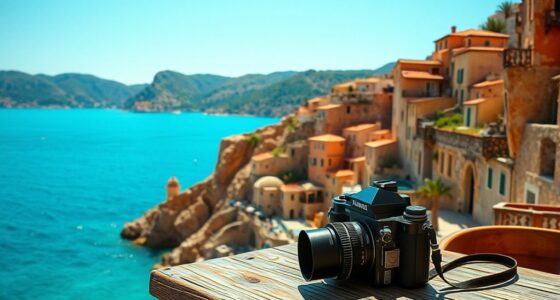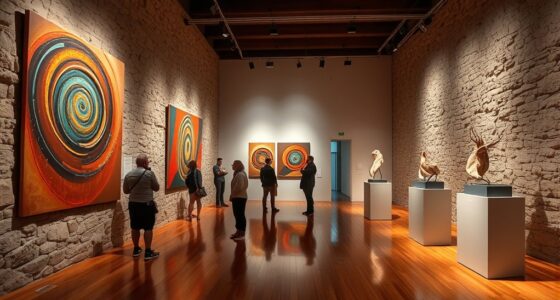Sardinian poetry is a vibrant cultural treasure, blending ancient oral traditions with modern literary creativity. It reflects regional identity, Mediterranean history, and diverse dialects through improvisational forms like mutetus and spontaneous performances at festivals. Poets and performers play essential community roles, preserving language and stories across generations. Today, initiatives and cultural districts work to sustain these traditions, enriching the global literary landscape. If you keep exploring, you’ll uncover even deeper stories behind this fascinating regional art.
Key Takeaways
- Sardinian poetry has ancient origins rooted in Bronze Age oral traditions and reflects regional identity through diverse dialects and themes.
- Improvisational forms like mutetu longu showcase spontaneous creativity and are performed during social gatherings, strengthening community bonds.
- The preservation of poetic techniques and language features maintains Sardinian cultural identity and highlights its historical and linguistic roots.
- Contemporary poets continue traditional practices, blending oral forms with written poetry, fostering a vibrant Sardinian literary revival.
- Sardinian poetry is recognized as a significant cultural treasure, connecting past traditions with modern cultural and artistic expressions.
The Ancient Roots of Sardinian Verse

The ancient roots of Sardinian verse lie deep in the island’s Bronze Age Nuragic civilization, where oral storytelling and artistic expression played a central role. You can see this in bronze figurines, or bronzetti, depicting storytellers or poets, which suggest a formalized poetic role within society. The Nuragic people relied on oral traditions to maintain social and natural order long before writing emerged. Their vibrant poetic culture thrived without leaving written texts, but archaeological finds hint at a rich oral tradition. Sardinians’ early poetic practices were shaped by Mediterranean trade, fostering cultural exchange that influenced poetic forms. These ancient roots laid a foundation for a resilient oral tradition that, despite modern influences, continues to shape Sardinian poetic expression today. The Nuragic civilization’s oral traditions remain a vital part of Sardinian cultural identity, underscoring the importance of poetry in preserving their history and social values. Additionally, the preservation of oral poetry has been supported by community practices and festivals that celebrate their poetic heritage.
Key Forms and Styles of Sardinian Poetic Expression
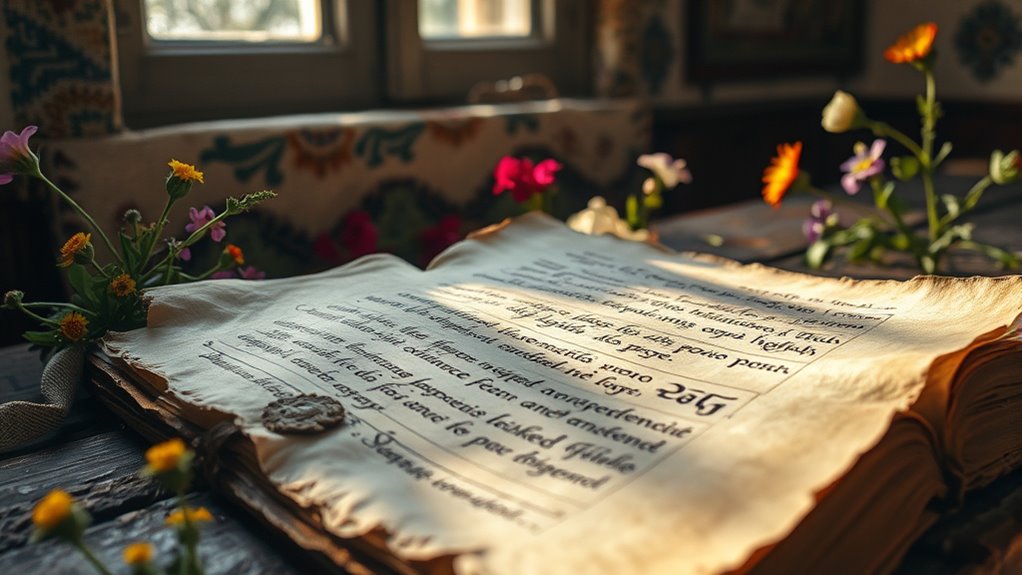
You can see that Sardinian poetry is shaped by improvisational forms like the mutetu longu, which showcase spontaneous creativity and complex structures. Dialectal and regional variations, such as Logudorese and Campidanese, give each poem its unique voice and cultural flavor. These key styles highlight how Sardinian poets preserve local identity through diverse, expressive traditions. Furthermore, the use of traditional oral techniques ensures the transmission of poetic skills and cultural values across generations. Additionally, understanding cultural preservation helps appreciate the significance of these poetic forms in maintaining Sardinian heritage.
Improvisational Mutetus Forms
Have you ever wondered how Sardinian poets craft their improvised verses on the spot? When performing mutetus, you become part of a live, spontaneous poetic duel. You create verses on the fly, often during public contests or social gatherings, using traditional forms like mutetu a otu peis and mutetu longu. These forms feature complex structures with repetitions, intertwined verses, and verbal inversions—hyperbaton—that give each performance a unique rhythm and style. You follow strict prosody rules, maintaining rhythmic and metrical patterns specific to Sardinian tradition. The mutetu longu, in particular, challenges you with its reversals and intricate repetition patterns, demanding both skill and quick thinking. This improvisational art connects you to centuries of Sardinian oral heritage, making each performance a vibrant, living expression of culture. It is deeply rooted in Sardinian history and continues to thrive today through dedicated practitioners. Additionally, the oral tradition sustains a sense of community and cultural identity among Sardinians.
Dialectal and Regional Variations
Sardinian poetic expression varies considerably across regions, with each dialect contributing its own distinctive style and flavor. In the north, Logudorese features unique sound shifts, like /pl/ becoming /pi/ and /r/ turning to /l/, creating a conservative, archaic tone. Nuorese, a sub-variety, preserves Latin traits, giving it a more traditional flavor. In the south, Campidanese reflects Italian influence, with rhotacized /s/ sounds and a different vowel system, shaping a more modern, accessible style. Northern variants like Sassarese and Gallurese blend Sardinian with Corsican, Ligurian, and Italian elements, enriching their poetic vocabulary. These regional differences influence diction, meter, and motifs, making Sardinian poetry a vibrant mosaic of linguistic identities rooted in local history and culture. Additionally, the diversity of dialects demonstrates how regional variations can foster unique poetic forms and stylistic expressions that reflect local identities and histories.
The Development of Written Literature and Its Legacy

You can see how Sardinian written literature began with early texts from the Phoenician period and evolved through the influence of Latin, Greek, and Spanish. Key figures like Gerolamo Araolla helped shape its development, while efforts to preserve oral poetry through transcription kept the culture alive. The earliest poetic compositions in Sardinia date back to the medieval period, reflecting a rich tradition of oral and written expression. This historical context highlights how literary evolution has been integral to maintaining Sardinia’s cultural identity. Today, this legacy continues to strengthen Sardinia’s unique literary identity and cultural pride.
Origins of Sardinian Texts
The origins of Sardinian texts reveal a rich tapestry of cultural exchange and oral tradition that dates back over three millennia. You learn that Sardinian poetic roots go to the Bronze Age Nuragic civilization, marked by artifacts like bronzetti statues depicting storytellers or poets. As a Mediterranean hub, Sardinia facilitated early cultural exchanges and oral storytelling. By the 1st century B.C., poets like Tigellius gained recognition in Roman circles, showing early written poetry. Villages preserved oral poetry and songs as essential cultural expressions. Ancient inscriptions feature Greek and Latin verses, highlighting engagement with classical traditions. These early texts and traditions laid the foundation for Sardinia’s distinctive literary identity, blending oral storytelling with emerging written forms that would shape its cultural legacy for centuries. The development of written language played a crucial role in preserving and transmitting poetic traditions across generations.
Key Literary Figures
As Sardinian oral traditions evolved, a handful of influential writers emerged, shaping the island’s literary landscape. Tigellius, a lyric poet in 1st century B.C. Rome, crafted satirical verses that irritated Cicero, revealing Sardinian influence early on. St. Lucifer of Cagliari defended Catholic orthodoxy against Arianism, while Bishop Eusebius enriched Sardinian religious and intellectual heritage. Moving into the 19th century, Melchiorre Murenu and Giovanni Spano promoted Sardinian language and literature. The medieval “condaghes” and inscriptions like those at Tuvixeddu laid foundational prose and poetic forms. These figures and texts created a legacy that continues influencing Sardinian identity and literary expression today. Additionally, literary development over centuries has helped preserve and celebrate Sardinian cultural identity through written works.
Preservation Efforts
Efforts to preserve Sardinian written literature have become essential in maintaining the island’s unique cultural identity. You can see this in the ongoing appreciation of ancient texts like the condaghes, which document social and religious history. These texts, such as *Il Condaghe di San Pietro di Silki*, connect past and present, inspiring modern writers. Additionally, festivals and competitions celebrating oral poetry keep traditional themes alive, emphasizing love, nature, and daily life. Modern authors draw on these roots, using Sardinian language to express local stories and emotions. Preservation initiatives focus on safeguarding the language and literary heritage, ensuring future generations recognize their cultural legacy. The recognition of Sardinian literary production has grown internationally, encouraging efforts to digitize and archive regional texts and promote their study worldwide. This ongoing effort strengthens Sardinian identity and highlights its significance within Italy’s diverse literary landscape.
Language as a Cultural Identifier in Sardinian Poetry
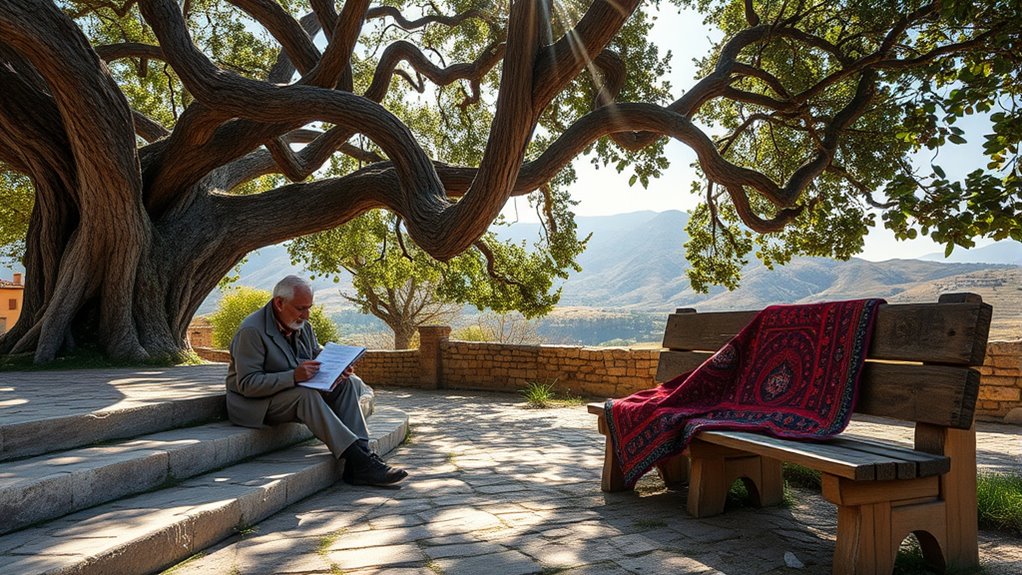
Sardinian poetry vividly showcases how language functions as a powerful symbol of regional identity. When you listen to or read these poems, you notice the language’s unique Latin roots and preserved archaisms, setting Sardinian apart. Its phonetic features, like the hard “g” and Latin “k” sounds, reinforce a sense of historical continuity. The vocabulary remains rich with Latin descendants, deepening cultural ties. Different regions preserve distinct poetic meters, acting as linguistic markers. The grammar’s resemblance to Latin, with gendered nouns and specific syntactic structures, highlights a connection to ancient traditions. Sardinian dialects are geographically distributed, each with unique poetic styles and influences. Through poetic expression, Sardinian language becomes a living emblem of local identity, history, and pride, linking past and present in every verse you encounter. Additionally, the preservation of archaic grammatical structures underscores the enduring connection between Sardinian poetry and its ancient roots.
The Social Significance of Poetic Traditions

Poetic traditions in Sardinia serve as essential social practices that strengthen community bonds and reinforce cultural identity. You experience this during social gatherings and festivals, where poetry becomes a shared activity that unites people across different backgrounds. The improvisational *mutetus* contests, for example, challenge participants to craft spontaneous verses, fostering camaraderie and local pride. These performances often reflect regional customs and values, helping you connect with your heritage. In rural and urban settings alike, poetry acts as a living tradition passed down through generations, ensuring cultural continuity. Approximately 250 titles are published annually in Sardinian literature, demonstrating the ongoing vibrancy and relevance of poetic expression. By engaging in these practices, you preserve Sardinian history and strengthen communal ties, making poetry more than art—it’s a crucial cultural expression of collective identity and social cohesion.
The Role of Poets and Performers in Community Life
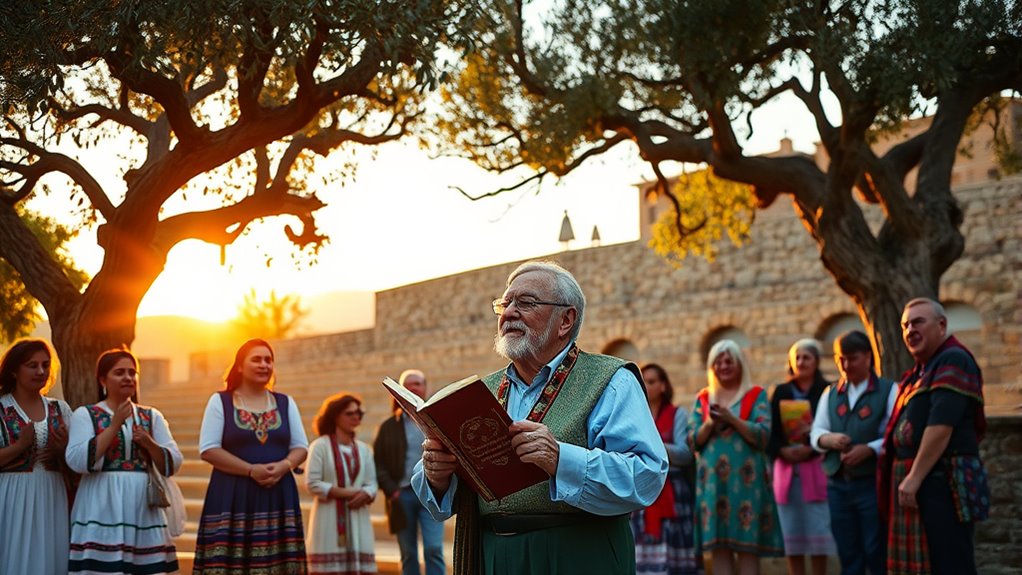
Throughout Sardinian communities, poets and performers have long played a vital role in shaping social life. You see them engaging in impromptu poetic competitions, exchanging rhymed verses during work and social gatherings. Their performances often take place in the streets, where verbal duels reinforce community bonds. Poets serve as keepers of local stories, values, and history, passing oral traditions from generation to generation. They embed social and political messages into their verses, sometimes using allegory and coded language to avoid censorship. Poets act as entertainers during festivals and work sessions, strengthening community ties through shared performances. They also represent regional pride, weaving local histories into their poetry, and fostering a sense of collective identity and cultural resilience. Sardinian oral tradition remains strong among peasants and shepherds, helping to preserve linguistic heritage despite limited literacy within dialects.
The Revival of Sardinian Poetry in Modern Times

The revival of Sardinian poetry today reflects a vibrant cultural resurgence rooted in centuries of linguistic and literary tradition. You’ll notice how modern poets draw inspiration from centuries-old works like *Sa Vitta et sa Morte* and *Rimas Spirituales*, which laid the groundwork for a distinct literary voice. Despite past foreign domination, the Sardinian language remained coherent, fostering a sense of identity that poets now revive and celebrate. Contemporary writers increasingly gain national and international recognition, contributing to a “Sardinian literary spring.” They blend oral poetic forms such as *Mutetus* and *Otada* with written poetry, ensuring regional diversity endures. By using dialects and regional variants, poets actively preserve linguistic heritage and reinforce Sardinian identity in a flourishing cultural landscape. Sardinian is recognized as a distinct language, which provides a strong foundation for its poetic renaissance. Additionally, the modern emphasis on cultural preservation helps sustain and promote the unique literary traditions of Sardinia.
Cultural Districts and Initiatives Supporting Poetry Preservation
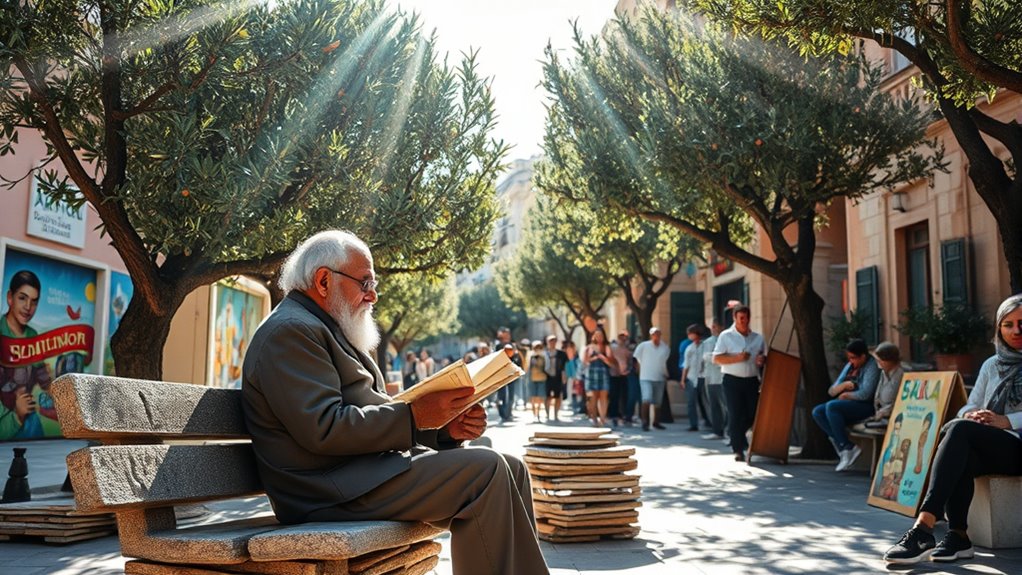
Sardinian cultural districts and local initiatives play an essential role in safeguarding the island’s rich poetic heritage. You’ll find the Nuorese area actively promoting its long-standing poetic traditions, while the Campidano region hosts the renowned Cantada Campidanesa—a lively extemporary poetry contest involving four poets and intricate traditional meters. Over the past 150 years, community efforts have produced more than 700 printed booklets documenting Campidanese poetry contests, preserving oral history. Rural villages turn informal gatherings into formal competitions, strengthening grassroots engagement. Numerous cultural events and festivals are dedicated to Sardinian poetry, further supporting its preservation. These districts serve as crucial hubs for both oral and written transmission, ensuring poetic traditions continue across generations. They foster cultural pride, encourage participation, and keep Sardinian poetry alive in local memory and community life.
Sardinian Poetry in Global Literary Context

Sardinian poetry actively contributes to a broader cultural renaissance that highlights the island’s unique identity within Italy and the global literary scene. You’ll notice that its works often blend languages and multicultural elements, challenging traditional Italian literary norms focused on uniformity. This diversity helps Sardinian poets gain recognition beyond regional borders, enriching European literature with fresh voices. The island’s geographic and cultural distance from mainland Italy fuels its distinct literary style, resonating internationally. Despite lacking a unified political identity, Sardinian literature maintains a strong cultural specificity that sets it apart. Its multilingual tradition, rooted in Sardinian, Italian, and Catalan, attracts global audiences and translators. By engaging with Mediterranean themes and minority languages, Sardinian poetry plays a essential role in fostering cultural diversity within the worldwide literary landscape. Sardinian poetry’s historical roots in minority languages continue to influence contemporary writers and expand its international reach.
Frequently Asked Questions
How Has Sardinian Poetry Influenced Contemporary Sardinian Identity?
You see, Sardinian poetry shapes contemporary identity by blending tradition with modern influences. It highlights the island’s unique connection to land, sea, and history, while addressing globalization’s impact. Through diverse themes and multilingualism, it fosters pride and cultural preservation. You’re part of a living tradition that unites rural and urban experiences, inspiring new generations to embrace Sardinia’s multifaceted identity and ensuring its cultural legacy endures.
What Are the Main Dialects Used in Sardinian Poetic Compositions?
You’ll find that Sardinian poetic compositions mainly use three dialects: Campidanese for oral, improvisational poetry in the south, Logudorese for literary and formal works, and Nuorese for local, conservative expressions reflecting regional identity. Each dialect has distinct features, with mutual intelligibility aiding poetic exchange. While some dialects like Sassarese and Gallurese are less common in poetry, the main dialects help preserve Sardinian culture through verse.
How Do Modern Poets Innovate Within Traditional Sardinian Poetic Forms?
When you explore how modern poets innovate within traditional Sardinian forms, you’ll find they blend old and new seamlessly. They adapt classical metrics like sonnets and strophic structures, reordering lines or using hyperbaton to refresh rhythm. By incorporating bilingual elements, codeswitching, and experimental rhyme, they preserve cultural roots while embracing contemporary themes like identity and migration. This creative fusion keeps Sardinian poetry vibrant, relevant, and deeply connected to both tradition and modernity.
What Role Do Women Historically Play in Sardinian Poetic Traditions?
You see, women in Sardinian poetic traditions have played crucial roles historically. They participated actively in public poetic competitions and singing sessions, often using wit and cultural knowledge to outperform male rivals. Women also preserved the Sardinian language and cultural identity through oral poetry, addressing themes like love and social issues. Their contributions challenged norms, expanded regional pride, and guaranteed the community’s stories and traditions endured across generations.
How Does Sardinian Poetry Compare to Other Mediterranean Poetic Traditions?
You see that Sardinian poetry stands out in the Mediterranean for its impromptu, competitive style and oral tradition. Unlike Greek poetry’s mythological focus or Spanish and Arabic poetry influenced by Moorish culture, Sardinian poetry emphasizes community, storytelling, and spontaneous performances. Its linguistic diversity and lively social gatherings make it unique, blending tradition with contemporary influences, and preserving its distinct cultural identity within the broader Mediterranean poetic landscape.
Conclusion
Imagine walking through a Sardinian village, where every verse echoes like a heartbeat, connecting past and present. Sardinian poetry isn’t just words; it’s a living tapestry woven with history, language, and community spirit. As poets continue to breathe life into these traditions, they keep the island’s soul vibrant and resilient—like a timeless melody that, no matter the era, still stirs hearts and sparks new stories.


